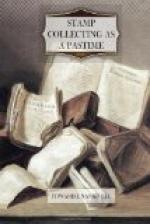Meanwhile, small struggling states revel in beautiful stamps. The latest trend is in the direction of miniature portraiture. The Argentine Republic and Bolivia have in recent years issued some very fine examples in this direction. A very useful innovation is the addition of the name under the portrait. In this way thousands have been familiarised with the names and faces of men who before were almost unknown beyond their own country. Historic features, such as those of Columbus and Pizarro, have occasionally been added to the growingly interesting gallery of stamp portraits.
The recently issued New Zealand picture series, illustrating most effectively some of the choicest bits of colonial scenery, and some of the rarest birds of the colony, engraved by Messrs. Waterlow and Sons, afforded an interesting and successful experiment in an art direction. As a result it is said that a strong demand has been generated in other colonies for similarly beautiful and localised designs in preference to the stereotyped mediocrity supplied by the ordinary label process.
[Illustration]
XIII.
Stamp Collecting as an Investment.
When a stamp collector is charged with being extravagant, with spending money lavishly and foolishly on a mere hobby, he may very justifiably reply that even his most extravagant spendings may be regarded as an investment.
The ordinary investor in, say, industrial securities is fairly content if he can, with a little risk, secure a steady six or seven per cent. If he launches out into more speculative shares, yielding higher rates of interest, he must be content to face a much greater risk of the capital invested. Now, the severest test of an investment is the yield of interest over a series of years covering periods of depression as well as periods of prosperity. The stamp collector who has used ordinary discretion in his purchases may confidently submit his investment to this test.
Some years ago, when I was writing in defence of stamp collecting as an investment, I received a very indignant letter from a collector who had made a large collection, complaining that he had then recently endeavoured to sell, but could get only a very small percentage of his outlay back, and that the very firms from whom he had bought most of his stamps scouted the idea of paying him anything like what they had cost him. He therefore ridiculed the idea that stamp collecting could be regarded as a safe investment, as in his case it had been a delusion and a snare. He was quite right, and it is still possible to make big collections—of, say, five thousand, ten thousand, and even larger—of stamps that are never likely to appreciate, and it is possible to buy those stamps at such a price that any attempt to realise even a small percentage of the original outlay must result in a woeful eye-opener.




